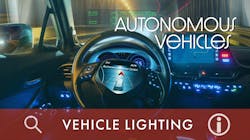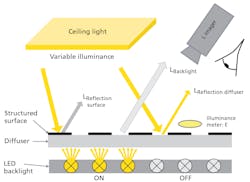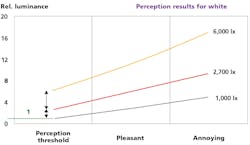Emerging technologies such as 5G, IoT, AI, and Big Data are bringing autonomous driving closer to reality. With continuous testing and improvement, it could minimize the human error factor that causes upwards of 42,000 automotive fatalities in the U.S. alone each year.1
Moreover, as market demands mature, automobiles will not only represent a means of transport, but also an extension of our daily living spaces. This article will envision how automotive interior lighting will improve functionality, visual acuity and comfort, and emotional experience in future vehicle designs.
Advanced light sources
Lighting technologies such as LED, OLED, fiberoptics, electroluminescent films, and light guides have rendered automotive interior lighting systems more cost-effective, multifunctional, and aesthetically pleasing.2
Reduced in bulk and providing more physically flexible linear options, interior functional lighting for passenger safety assurance includes ceiling-integrated dome and map lights, backlit instrument panels, and door panel lamps that turn on when the doors open.2
Compact LED light guides are frequently used for interior illumination, in direct-lit or side-lit methods, due to their luminance, uniformity, and dynamic color-changing capability (see Fig. 1).
Furthermore, functional lighting has expanded its role beyond general illumination to provide critical information and interactive entertainment via head-up displays (HUDs), electronic screens, and other audiovisual projection devices. Successful automotive interior lighting schemes will require functionality to be balanced with thoughtful application guided by parameters covered in the next section.
Design rules for proper perception and comfort
With the increasing number of self-illuminated devices onboard, autonomous vehicle designers should consider three guidelines to support passengers’ visual perception and comfort.
First, interior ambient lighting — namely, total diffused or reflected luminance from interior surfaces — should not be higher than the threshold luminance required for perception of the LED backlight.
Second, interior light levels should be responsive — that is, automatically adjustable according to the time and weather during each day — so passengers’ visual adaptation to varying brightness levels will not be frequently affected as their focus switches from inside and outside of the vehicle.
Third, automotive designers should minimize glare from interior lighting and exterior daylight. Careful implementation of light source and interior materials selection for their smoothness or texture, color, and size will help lessen glare.
Interior lighting test setup
A study by Caberletti et al. (2014) found interior lighting significantly affected driver perception in a conventional car during nighttime hours. Researchers reported that interior illumination facilitated users’ ability to locate and operate controls, intensified spatial perception, enhanced the perceived quality of materials and design, and improved perceived safety.3
Figure 3 shows the setup for the devices tested. An output-adjustable ceiling light panel simulated three typical interior illuminance levels — 1,000, 2,700, and 6,000 lx — generated under various daylight conditions, with an incident angle of 60° to the target surface.4
From a driver or front passenger perspective, the measured total reflected luminance by the structured surface and diffuser (with backlight off) were 20 cd/m2 for 1,000 lx and 120 cd/m2 for 6,000 lx, respectively.4
For the diffuser output or display to be discernible, the required minimum visual contrast (or threshold contrast) could be defined as5:
Where:
Ld is the diffuser luminance; Lr is the total reflected luminance; and Ld > Lr. Both units are expressed in cd/m2.
Figure 4 shows the result of user preference–based LED backlight luminance corresponding to three different daylight levels. The values were normalized to the smallest threshold luminance value at 1,000-lx interior illuminance. The study has demonstrated that at a 1,000-lx threshold, the backlight luminance is about 50% higher than the reflected luminance.4
Several observations can be obtained from the study results in Fig. 4:
- Higher interior illuminance led to higher “Threshold Perception” luminance.
- The luminance range for “Perception Threshold,” “Pleasant,” and “Annoying” became wider as the interior illuminance increased.
- “Pleasant” and “Annoying” perceptions related to a greater backlight-luminance-to-reflected-luminance ratio.
No standards for glare
Glare can cause visual disability or discomfort, depending on the degree to which it affects human visual acuity at any time of day. According to a 2019 study, aging eyes are more sensitive to glare.5 Previous studies proved that disability and discomfort glare originating from nighttime interior lighting can be eliminated3 by keeping the maximum luminance below 0.1 cd/m2.
Under daylight conditions, interior displays can be rendered unreadable due to washout or glare, causing driver or passenger distraction, or masking critical information. With an increasing number of vehicle systems being controlled through a centralized display, the legibility of automotive screens under interior and exterior lighting conditions is essential.6
Standards or guidelines concerning glare from vehicle interior lighting do not yet exist.7 The well-known Unified Glare Rating (UGR) is restricted for use under certain conditions, per the CIE 117 standard8:
- For indoor lighting and electrical lighting design only.
- For uniform background luminance.
- Not for small light sources (subtending < 0.0003 sr).
- Not for large light sources (subtending > 0.1 sr).
- Not for indirect lighting.
The suitability and practicality of employing UGR in evaluating vehicle interior-lighting glare has yet to be explored.
Lighting for user preferences
Research shows that many people desire adjustable interior lighting options in an autonomous vehicle9, indicating that mood enhancement, ambience, and aesthetics are also important to prospective passengers.
Autonomous vehicle interior lighting systems need not be restricted to adjustments in brightness, contrast, and color temperature. Dynamic color changing can also add value to the passenger experience. For example, one might prefer to adopt a sunny, beachlike lighting scheme on a cold and rainy winter morning, or perhaps a calming and cool forestry environment during a hot, dry summer day. Lighting could also be responsive to the music played in the vehicle. Such features will bring many opportunities for automotive manufacturers to distinguish their brands and develop their own criteria for unique vehicle experiences.
Conclusion
Autonomous vehicles will elevate travel and commuting experiences to new heights of customization and comfort. With the integration of the latest technology, automotive interior lighting will become more safe, elegant, intelligent, and energy efficient, serving both human visual needs and overall wellbeing.
References
1. Y. Zhu, “Luminance inequality in road lighting-considerations of road pavement reflectance: part 2, Conclusions,” Lighting Art & Science, Issue June/July, 32–38 (2020).
2. J. Devonshire et al., “Effects of automotive interior lighting on driver vision,” The University of Michigan, USA (2007).
3. L. Caberletti et al., “Influence of ambient lighting in a vehicle interior on the driver’s perceptions,” Lighting Res. and Technol., 42, 297–311 (2010).
4. Blankenbach et al., “Advances in automotive interior lighting concerning new LED approach and optical performance,” J. Society for Information Display (2020).
5. Y. Zhu. “Road lighting disability glare-a study comparing LEDs with HPS,” Lighting Art & Sci., Issue June/July, 32–39 (2019).
6. C. White. “Recreating daylight for vehicle interior evaluations,” University of Warwick, UK (2017).
7. K. Rumar. “Vehicle lighting and the aging population,” The University of Michigan, USA (1998).
8. I. Ashdown et al., “NEMA LS 20001-2021 White paper on Unified Glare Rating (UGR),” National Electrical Manufacturers Association, Rosslyn, Virginia (2021).
9. N. Torchalski et al., “Autonomous vehicle interior design,” Honors Theses, 3225 (2019).
YUNYU “CLAUDE” ZHU is a lighting engineer based in Australia. With a bachelor's degree in optical science from China's Northwest University and a master's degree in lighting from Queensland University of Technology, he has been working in the industry since 2009, leaving his footprint in China, Saudi Arabia, New Zealand, and Australia. In addition to lighting, Zhu has a deep interest in science, philosophy, and nature.
For up-to-the-minute LED and SSL updates, follow us on Twitter. You’ll find curated content and commentary, as well as information on industry events, webcasts, and surveys on our LinkedIn page and our Facebook page.










